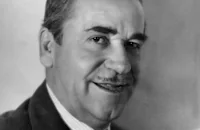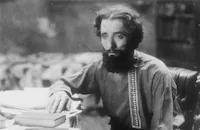Noah's Ark

Brief Synopsis
Cast & Crew
Michael Curtiz
Dolores Costello
George O'brien
Noah Beery
Louise Fazenda
Guinn "big Boy" Williams
Film Details
Technical Specs

Synopsis
On a train from Constantinople to Paris in 1914, Mary (an Alsatian girl with a theatrical troupe), two American youths (Bill and Al), a German, a Frenchman, a Russian, and a minister become involved in an argument over Christianity which is abruptly terminated by a collision. All find shelter in a nearby inn where a fight ensues; and Hilda, the innkeeper, contrives the escape of Travis, Mary, and Al as a cavalry troop arrives with the news that war has been declared. ... In Paris, Travis and Mary fall in love, and soon Al enlists, as does Travis; meanwhile, Mary becomes a canteen dancer searching for Travis. When Mary repulses a Russian's advances, he causes her to be incriminated as a German spy; but on the day set for her execution, Travis recognizes her at the last minute. Comparison is made at this point between the World War situation and the Biblical account of the Flood: At the Festival of Jaghut, the revelries are to climax with a human sacrifice, while Noah and his small following reside in primitive simplicity on the outskirts of the city. A group of carousing soldiers see Miriam, betrothed of Japheth, the youngest of Noah's three sons, and carry her away for the king, who, struck by her beauty, orders that she be prepared for the sacrifice; meanwhile, Noah receives a message from God directing him to build and provision the Ark. Noah interrupts the festival, warning of the consequences; and as the high priest prepares to kill Miriam, a bolt of lightning strikes him and a second bolt topples the idol. As water floods the temple, Japheth's sight is miraculously restored and he rescues Miriam; and borne on the waters, they reach the Ark and are received by Noah. Reverting to the modern story, Red Cross workers are busy administering to the war injured when a messenger arrives, bringing news of the Armistice; and Mary and Travis, though tattered and dirty, join in the celebration of a new era of peace.

Director

Michael Curtiz
Cast

Dolores Costello

George O'brien

Noah Beery

Louise Fazenda

Guinn "big Boy" Williams
Paul Mcallister

Nigel De Brulier
Anders Randolf

Armand Kaliz

Myrna Loy

William V. Mong
Malcolm Waite
Noble Johnson
Otto Hoffman
Joe Bonomo
Crew
De Leon Anthony
Anthony Coldeway
Anthony Coldeway
Fred Jackman
Harold Mccord
Barney Mcgill
Hal Mohr
Billy Rose
Louis Silvers
Louis Silvers
Darryl Francis Zanuck

Videos
Movie Clip



Trailer
Film Details
Technical Specs

Articles
Noah's Ark (1929) - Noah's Ark
The scope and budget was certainly big for its time and a major undertaking for a young, aspiring movie mogul like Darryl F. Zanuck. His career at Warner Brothers began as a writer in 1924. Ever ambitious, he established himself as a producer within four years. Noah's Ark was his first film assignment and - befitting his youthful enthusiasm (he was only 26 years of age), he vowed to "make the greatest picture ever made". Although that statement is a bit lofty, Noah's Ark is still a remarkable film on many levels.
Probably the most astonishing sequence is the Flood, which is still impressive by today's special effects standards and was every bit as harrowing to shoot as it appears onscreen. Curtiz had a huge tank containing more than a million gallons of water constructed with access spillways leading to the tops of the Babylonian temple set. Sadly, his zeal to obtain authenticity in this scene made him shamefully neglectful of safety precautions. His emphasis on realism was so intense that when cinematographer Hal Mohr (a survivor of the 1906 San Francisco earthquake and fire) questioned him about the lack of adequate safeguards for the film's players, Curtiz reportedly replied, "They're just going to have to take their chances." Mohr was so appalled at Curtiz's comment that he walked off the set and his duties were taken over by Barney McGill. But the deadly stunt proceeded as planned. The contents from the tanks were released and 15 cameramen and countless extras thrashed about in the water for hours. Many extras were injured (one reportedly died, but this morbid rumor has never been confirmed), but they were not alone in their pain. The film's leading lady, Dolores Costello, developed pneumonia for being in the water too long and Guinn Williams injured two ribs!
Before one judges director Michael Curtiz too harshly, it should be said in his defense that he was working for one of the most micro-managed, accountancy-oriented studios in Hollywood. And Curtiz, still a relative newcomer (he was brought to Hollywood by Jack Warner only two years prior) felt obliged to turn out his first big film as a director on time and on budget. which he always did - using his natural gifts of meticulousness, speed and technical ability. In fact, these qualities would make him the most prolific director of the following decade: an amazing 44 completed feature films between 1930 and 1939. Granted, some of these varied in quality and production values, but a number of these film are classics: Mystery of the Wax Museum (1933), Captain Blood (1935) and Angels with Dirty Faces (1938) to name a few. Followers of silent films should relish the performance of Noah Beery. Although now he's known as the brother of Wallace Beery and the father of Noah Jr. (James Garner's dad "Rocky" in the Rockford Files), he was arguably the busiest villain during the silent era (he had made over 60 features by the time of Noah's Ark). Beery was the classic heavy, a powerful presence with a wicked grimace and a deep, resonant voice that was as seductive as it was menacing. His performance here strikingly captures the essence of why he was such a fine and popular villain for so many years.
On the other hand, fans of Myrna Loy may be disappointed by her lack of screen time in this film. She appears as one of the dancing girls in the Broadway sequence and as a slave in the Biblical sequence - small parts which only garnered her a tenth place billing in the credits. This was often the case during her stint with Warner Brothers where she was relegated to being a little more than a bit player at the studio. Luckily, her fortune improved when her contract was picked up five years later by MGM and Loy assumed the role of the sophisticated, elegant leading lady in refined comedies like The Thin Man (1934) and Libeled Lady (1936).
Yet despite all the efforts of those involved, Noah's Ark failed domestically at the box-office and with the critics. The New Yorker called it "an idiotic spectacle", while The New York Times stated that the film "frequently bordered on the ridiculous". It did however, have a much better reception in Europe, where it almost recouped its budget of $1.5 million. Even today, film historians view Noah's Ark as an important early talkie artifact. It's also the first notable American film in the career of the prolific Curtiz. There is also a relevant connection between this film and the current cinema; the film's heroine, Dolores Costello, was one of the leading box-office attractions of the late silent and early sound era and also happens to be the grandmother of Drew Barrymore!
Producer: Robert Youngson (uncredited), Darryl F. Zanuck (associate) (uncredited)
Director: Michael Curtiz, Darryl F. Zanuck (uncredited)
Screenplay: De Leon Anthony (titles), Anthony Coldeway (adaptation) (as Anthony Coldewey), Darryl F. Zanuck (story)
Cinematography: Barney McGill, Hal Mohr
Film Editing: Harold McCord
Original Music: Alois Reiser (uncredited), Louis Silvers
Principal Cast: Dolores Costello (Mary/Miriam), George O'Brien (Travis/Japheth), Noah Beery (Nickoloff/King Nephiliu), Louise Fazenda (Hilda/Tavern maid), Guinn 'Big Boy' Williams (Al/Ham) (as Gwynn Williams), Paul McAllister (Minister/Noah), Myrna Loy (Dancer/Slave Girl).
BW-100m.
by Michael Toole

Noah's Ark (1929) - Noah's Ark
Quotes
This war is more than just a fight. It's more like a funeral. And everybody ought to be in the procession or the hearse.- Al
Trivia
Three extras drowned during the filming of the flood scene.
One of the extras who survived the flood scene was 'John Wayne' .
When cameraman Hal Mohr was shown how the climactic flood scene was to be shot, he objected on the grounds that it would place many of the extras in jeopardy. Mohr told the executives that while the trained stuntmen knew what to expect, the ordinary extras would have no idea what was coming, and many would be hurt. When his objections were overruled, he quit the picture. During filming of the scene, the huge torrents of water overwhelmed the actors; three were drowned, one was so severely injured his leg had to be amputated, and almost a dozen had broken limbs and other serious injuries.














